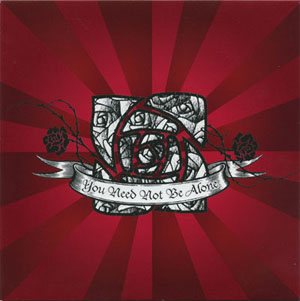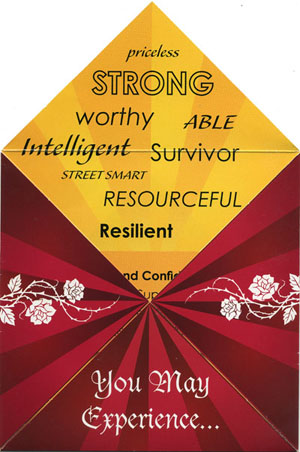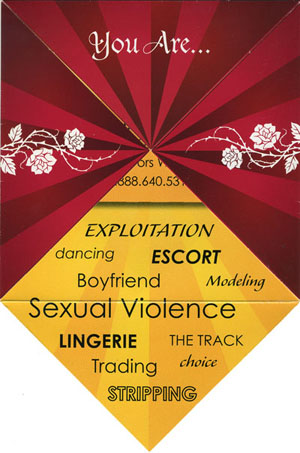Last July, I debunked the false claim that “the average age of entry into prostitution” is somewhere around 13, which has been in circulation among anti-trafficking groups, politicians, and media.
But that is not the only falsehood that is passed off as a fact about domestic minor sex trafficking. Another oft-repeated claim is found in the 2010 Congressional testimony by Ernie Allen, president and CEO of National Center for Missing and Exploited Children, otherwise a legitimate and reputable organization:
Some runaway groups have estimated that as many as 1/3 of teen runaways/thrownaways will become involved in prostitution within 48 hours of leaving home.
This “statistics” is often presented without source, or attributed to the National Incidence Study of Missing, Abducted, Runaway and Thrownaway Children (NISMART-2), which has been compiled by Office of Juvenile Justice and Delinquency Prevention, U.S. Depart of Justice.
For example, “U.S. Trafficking Facts,” a document created by anti-trafficking group Love146 states:
Astonishingly, with in the first 48 hours of being on the street, 1 in 3 children are lured into prostitution (National Incidence Study of Missing, Abducted, Runaway and Thrownaway Children/NISMART-2)
However, NISMART-2 does not include any such information. And yet, variations of this factoid are repeated by many other anti-trafficking groups as well.
An estimated 1.6 million children run away from home each year in the US. The average time it takes before a runaway is approached by a trafficker or solicitor is 48 hours (National Runaway Switchboard)
GEMS (Girls Educational & Mentoring Services)
It is estimated that it takes as little as 48 hours for a child to be lured into exploitation by individuals promising love, money and lavish lifestyles
Rebecca Project for Human Rights
Within 48 hours of hitting the streets, one-third of these children are lured or recruited into the underground world of prostitution and pornography (The National Center for Missing and Exploited Children)
Stop Child Trafficking Now
As many as 2.8 million children live on the streets, a third of whom are lured into prostitution within 48 hours of leaving home
Shared Hope International
There are more, but I’ll stop here.
There are some variations: some attribute the data to NISMART-2, while others attribute it to Center for Missing and Exploited Children or National Runaway Switchboard–these two organizations don’t have any report showing this data either. Also, some groups claim that one third of runaway youth are trafficked within 48 hours, while others say it takes an average of 48 hours for someone to be trafficked, or simply that it may only take 48 hours for some to be trafficked.
Where does the factoid come from? The only document that show some actual numbers is on the website of Gracehaven House, a faith-based organization in Northwest Ohio providing “shelter, security, and rehabilitation” to female victims of commercial sexual exploitation under the age 18. On its “fact sheet” about CSEC, Gracehaven House cites another Ohio group, Huck House. The document states:
Huck House FY 2007
– Served 1,409 youth in 2007
– Approximately 600 girls
– 1/3 will be approached within 48 hours by a pimp
– 200 girls <18 approached by a pimp
– 60-90 involved in prostitution
Huck House, or Huckleberry House is an organization in Columbus, Ohio that provides safe place for runaway youth. The one-third figure seem to come from the survey of its client/participant base for FY 2007, which included about 800 boys and 600 girls. Assuming that this report is accurate, here are some things to consider:
1) The one-third figure is often presented as a national data (attributed to NISMART-2, Center for Missing and Exploited Children, or National Runaway Switchboard) but it is based on a survey of participants at a Columbus, Ohio social service agency.
2) It is often claimed that one third of runaway youth are recruited into prostitution within first 48 hours, but the data do not support this. Huck House figure states that one third of girls who came to Huck House have been approached, but if all “runaway youth” are included the figure is close to 14%, not 33%.
3) That one third of girls who showed up at Huck House have been approached by a pimp does not mean that one third of runaway girls are. Here’s why:
If we assume, reasonably, that short-term or casual runaway youth (which comprise majority of runaways) are far less likely to be approached by a pimp or engage in prostitution than those who run away longer period of time or farther distances, many of the girls who are not approached by a pimp and don’t even come close to it go home (or find other arrangements) without showing up at Huck House’s door.
To illustrate this point, let’s imagine that 100 girls ran away from home in a hypothetical city or region. Imagine that 70 of them are casual runaways (i.e. low risk of being exploited), and 30 are high-risk runaways. Pimps generally approach girls in the high-risk group, so let’s say 10 out of the 30 are approached. Once the 70 casual runaways return home or find other arrangements, it leaves 30 longer-term, high-risk runaway youth who show up at Huck House.
Huck House surveys those 30 who showed up, and report that a third of its client base have been approached by a pimp. But you cannot conclude, based on this figure, that a third of all runaway youth (or just girls) are approached: we started with 100 girls, 10 of whom are approached, so the actual rate is 10%.
In short: Huck House, or other groups like it, does not serve a representative sample of runaway youth; they serve those who are part of a higher risk group. Therefore, you cannot take figures from its survey and generalize it to the entire runaway youth population.
4) Even though a third of the girls who showed up at Huck House report to have been approached by a pimp within 48 hours, only 10-15% of the girls (60-90 out of 600) at Huck House are involved in prostitution (and this includes any girl who became involved at any point, not just within the first 48 hours), according to Huck House.
In other words, it is false to claim that one third of the girls at Huck House are “forced into prostitution” or “trafficked,” as some anti-trafficking groups claim; they are simply “approached”–and at least a majority of girls are smart and empowered enough to turn them down.
Further, if we include all youth into the analysis (and there is no reason not to, because anti-trafficking groups claim that one third of all runaway youth are recruited, not just girls), it is 60-90 youth at Huck House among 1400 total. That is 4-6% of the group surveyed, far lower than the anti-trafficking groups’ claim.
None of us wants to see any number of (non-casual) runaway youth, whether 33% or 4%, having to engage in prostitution to survive on the street. But there is a huge gap between the claim that “one third of runaway youth are trafficked within the first 48 hours on the street” and the actual figure of 4-6% over the course of homelessness.
Bad factoids misinform the public about this very important issue and mislead our discussions over what to do about it. Those who traffic fake statistics and launder its true source must stop doing so.
Case in point: just a couple of months ago on this blog, I criticized GEMS for using this fake factoid on its main site. Later, in mid-March, I took a screen capture of the site, showing the line about “48 hours” myth, in preparation for my lecture at Grand Valley State University.
But when I visited the site again today, I found that GEMS had removed a line about the “one third” figure from its main site. The quote you saw earlier on this post is actually from GEMS’ ning group, because the main site no longer carries this fake factoid.
I don’t know if my criticism had anything to do with this, but good job, GEMS! Please also start verifying other equally questionable factoids on your site too! And please be brave and be more transparent about why you have removed that information, rather than just quietly removing it from the main site, because it will help other anti-trafficking groups recognize the errors they have made as well.





